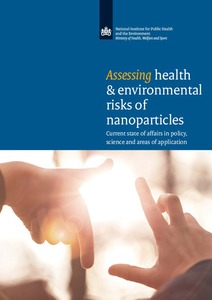Assessing health and environmental risks of nanoparticles: current state of affairs in policy, science and areas of application
"Nanoparticles are ultrafine particles with exceptional properties that give them unbounded possibilities. They can add extra strength to materials and objects, make solar cells work more efficiently, and direct medicines straight to the place where the human body needs them. These highly promi...
| Institution: | ETUI-European Trade Union Institute |
|---|---|
| Format: | TEXT |
| Language: | English |
| Published: |
Bilthoven
2015
RIVM |
| Subjects: | |
| Online Access: | https://www.labourline.org/KENTIKA-19112874124919300569-assessing-health-and-environme.htm |
| Summary: | "Nanoparticles are ultrafine particles with exceptional properties that give them unbounded possibilities. They can add extra strength to materials and objects, make solar cells work more efficiently, and direct medicines straight to the place where the human body needs them. These highly promising properties are the reason why so much is being invested in nanotechnology and why it has become part and parcel of modern society. However, nanoparticles possess different properties and behave differently to the classical, larger building blocks of substances. The existing models and techniques used to assess the risks of nanoparticles and nanomaterials are not yet sufficiently tuned to determine how harmful they are to people and the environment. There are indications that some nanoparticles exhibit harmful properties, but exactly why this is true of these particular particles is unknown, and it certainly does not apply to all nanoparticles and nanomaterials.
These are the main conclusions of an overview produced by the Dutch National Institute for Public Health and the Environment (RIVM) of the scientific knowledge of risk assessments of nanoparticles and nanomaterials and their applications. The information in the report includes a description of the current European regulatory regime. General insights have been amplified for some distinct fields such as consumer products, food, medical applications, workplace applications and the environment.
The risks attached to products currently under development have to provisionally be examined within certain confines to be able to make an assessment of them. RIVM has flagged the need to adopt a more pragmatic approach. The rapid pace of new developments makes it necessary to continue devoting attention to how risk assessments must be designed and to how to deal with the uncertainty surrounding potential risks. New approaches like 'safe innovation', that make product safety part of the innovation process, are helpful.An effective system and assessment framework is necessary for the long haul. Key components are data about the behaviour of nanoparticles and nanomaterials and knowledge of how to predict their properties. Increased attention needs to be directed towards the new generations of nanomaterials that are on the horizon, such as self-organising materials, because the development of knowledge of these particles and materials is still in its infancy." |
|---|---|
| Physical Description: | 149 p. Digital |

